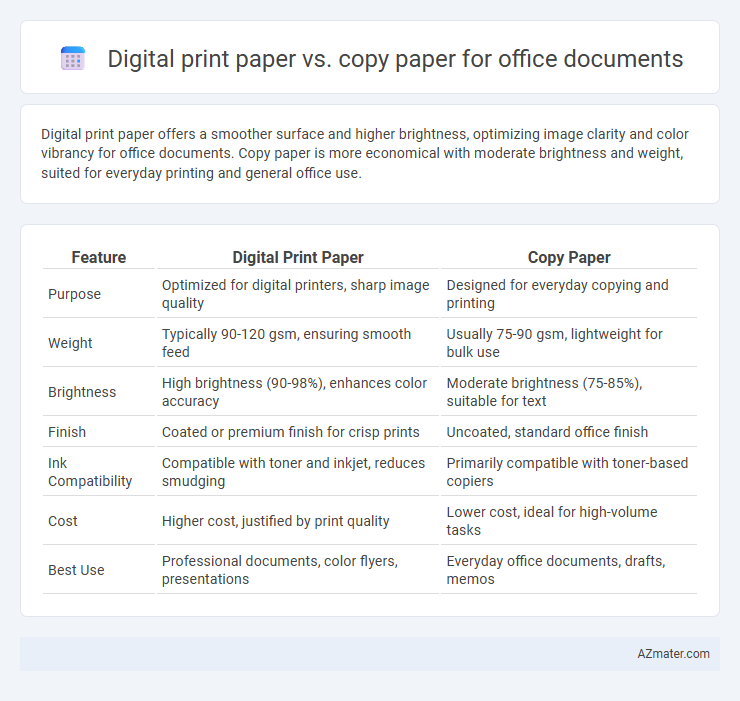Digital print paper offers a smoother surface and higher brightness, optimizing image clarity and color vibrancy for office documents. Copy paper is more economical with moderate brightness and weight, suited for everyday printing and general office use.
Table of Comparison
| Feature | Digital Print Paper | Copy Paper |
|---|---|---|
| Purpose | Optimized for digital printers, sharp image quality | Designed for everyday copying and printing |
| Weight | Typically 90-120 gsm, ensuring smooth feed | Usually 75-90 gsm, lightweight for bulk use |
| Brightness | High brightness (90-98%), enhances color accuracy | Moderate brightness (75-85%), suitable for text |
| Finish | Coated or premium finish for crisp prints | Uncoated, standard office finish |
| Ink Compatibility | Compatible with toner and inkjet, reduces smudging | Primarily compatible with toner-based copiers |
| Cost | Higher cost, justified by print quality | Lower cost, ideal for high-volume tasks |
| Best Use | Professional documents, color flyers, presentations | Everyday office documents, drafts, memos |
Understanding Digital Print Paper and Copy Paper
Digital print paper is designed for high-resolution printing with specialized coatings that enhance ink absorption and reduce smudging, making it ideal for photo-quality documents and professional presentations. Copy paper, typically made from lower-grade pulp, is optimized for everyday office use, supporting general printing and photocopying with reliable feed and minimal jamming. Understanding the differences in weight, brightness, and surface finish helps select the right paper type to ensure optimal print quality and device performance.
Key Differences in Paper Composition
Digital print paper is engineered with a smoother, tighter surface and higher brightness to enhance toner adhesion and image clarity, featuring a special coating that prevents ink bleed and smudging during high-speed printing. In contrast, copy paper has a more porous texture with less emphasis on surface uniformity, designed primarily for basic ink absorption suitable for everyday office printing and copying tasks without the need for advanced print quality. The fiber content in digital print paper typically involves higher-quality pulp and additives to improve durability and prevent curl, whereas copy paper uses standard pulp blends optimized for cost-efficiency and volume.
Print Quality: Digital Print Paper vs Copy Paper
Digital print paper delivers superior print quality with higher brightness, smoother surface, and optimized ink absorption, resulting in sharper images and vibrant colors ideal for professional presentations. Copy paper, designed for everyday use, has a rougher texture and lower brightness, which may cause ink bleeding and less crisp output in high-resolution prints. Selecting digital print paper ensures enhanced clarity and durability, especially for documents featuring graphics and detailed text.
Performance in Modern Office Printers
Digital print paper offers superior ink absorption and color vibrancy, making it ideal for high-resolution graphics and professional documents in modern office printers. Copy paper, while suitable for everyday printing tasks, typically has lower brightness and weight, which can result in slower drying times and less crisp print quality. Modern office printers optimize their performance with digital print paper by delivering sharper images and reducing paper jams due to its consistent thickness and smooth texture.
Cost Comparison: Which Paper is More Economical?
Digital print paper typically costs more per ream than copy paper due to its enhanced brightness and smoother finish designed for high-quality ink and toner performance. Copy paper is more economical for everyday office documents and bulk printing, offering sufficient quality at a lower price point. Firms prioritizing budget efficiency usually opt for copy paper unless print quality demands justify the premium digital print paper.
Environmental Impact and Sustainability
Digital print paper is designed to withstand high heat and toner adhesion without releasing harmful chemicals, making it more environmentally friendly compared to conventional copy paper, which often uses more energy-intensive bleaching processes. Copy paper production typically involves higher water consumption and deforestation rates, contributing to a larger carbon footprint and reduced sustainability. Choosing FSC-certified digital print paper further supports sustainable forestry and reduces overall environmental impact in office document printing.
Durability and Document Lifespan
Digital print paper features a specially coated surface that enhances ink adhesion and prevents smudging, resulting in sharper and more durable prints compared to standard copy paper. Its higher durability supports longer document lifespan by resisting fading and deterioration under frequent handling and exposure to light. Copy paper, while suitable for everyday printing, tends to degrade faster and is more prone to ink bleeding, making it less ideal for important office documents requiring extended preservation.
Best Uses for Digital Print Paper
Digital print paper is specifically designed to handle high-resolution images and vibrant colors, making it ideal for marketing materials, presentations, and professional reports. Its smoother surface and heavier weight enhance print quality, reducing ink absorption and preventing smudging during digital printing processes. Unlike standard copy paper, digital print paper ensures sharper text and graphics, improving the overall impact of office documents that require precise and visually appealing output.
Ideal Applications for Copy Paper
Copy paper is ideal for everyday office documents such as memos, drafts, meeting agendas, and internal reports where high-quality print resolution is not critical. It offers reliable performance in high-speed copiers and laser printers, making it cost-effective for bulk printing tasks. Designed for versatility, copy paper handles standard ink absorption, ensuring clear text reproduction and smooth feeds without jamming or smudging.
Choosing the Right Paper for Your Office Needs
Digital print paper offers superior image quality and ink absorption, making it ideal for high-resolution color documents and presentations. Copy paper is more cost-effective and suitable for everyday printing, such as internal memos and draft documents. Evaluating the print volume, color requirements, and budget will help determine whether digital print paper's premium finish or copy paper's economy best fits your office needs.

Infographic: Digital print paper vs Copy paper for Office document
 azmater.com
azmater.com